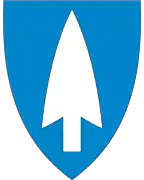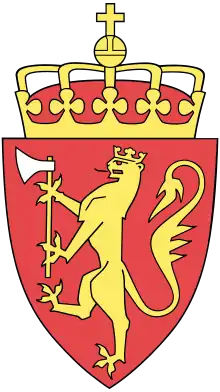Odda
Odda (![]() pronunciation ) is a former municipality in the old Hordaland county, Norway. The municipality existed from 1913 until its dissolution in 2020 when it was merged into Ullensvang Municipality. It was located in southeastern Hordaland county, surrounding the southern end of the Sørfjorden. The administrative centre was the town of Odda, which was also the main commercial and economic centre of the entire Hardanger region. Other villages in the municipality included Botnen, Eitrheim, Håra, Røldal, Seljestad, Skare, and Tyssedal.
pronunciation ) is a former municipality in the old Hordaland county, Norway. The municipality existed from 1913 until its dissolution in 2020 when it was merged into Ullensvang Municipality. It was located in southeastern Hordaland county, surrounding the southern end of the Sørfjorden. The administrative centre was the town of Odda, which was also the main commercial and economic centre of the entire Hardanger region. Other villages in the municipality included Botnen, Eitrheim, Håra, Røldal, Seljestad, Skare, and Tyssedal.
Odda kommune | |
|---|---|
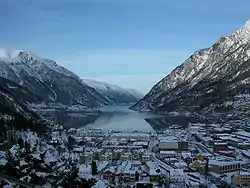 View of the town of Odda | |
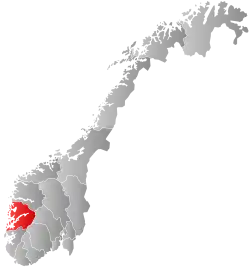 Hordaland within Norway | |
 Odda within Hordaland | |
| Coordinates: 60°04′00″N 06°32′46″E | |
| Country | Norway |
| County | Hordaland |
| District | Hardanger |
| Established | 1 July 1913 |
| Disestablished | 1 Jan 2020 |
| Administrative centre | Odda |
| Government | |
| • Mayor (2015) | Roald Aga Haug (Ap) |
| Area | |
| • Total | 1,615.89 km2 (623.90 sq mi) |
| • Land | 1,475.43 km2 (569.67 sq mi) |
| • Water | 140.46 km2 (54.23 sq mi) 8.7% |
| Area rank | 42 in Norway |
| *Area at municipal dissolution. | |
| Population (2019) | |
| • Total | 7,025 |
| • Rank | 150 in Norway |
| • Density | 4.8/km2 (12/sq mi) |
| • Change (10 years) | −1.8% |
| Demonym(s) | Odding[1] |
| Time zone | UTC+01:00 (CET) |
| • Summer (DST) | UTC+02:00 (CEST) |
| ISO 3166 code | NO-1228 |
| Official language form | Neutral[2] |
| Preceded by | Ullensvang in 1913 |
| Succeeded by | Ullensvang in 2020 |
| Website | odda |
Prior to its dissolution in 2020, the 1,616-square-kilometre (624 sq mi) municipality was the 42nd largest by area out of the 422 municipalities in Norway. Odda is the 150th most populous municipality in Norway with a population of 7,025. The municipality's population density is 4.8 inhabitants per square kilometre (12/sq mi) and its population has decreased by 1.8% over the last decade.[3]
In 1927, Erling Johnson, working at Odda Smelteverk, invented a process to produce three-component, NPK fertilizers. This process is now known as the Odda process.
General information
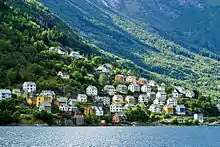
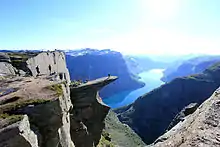

The municipality of Odda was established on 1 July 1913 when the southern district of Ullensvang was separated out to form its own municipality. Initially, Odda had 3,077 residents. During the 1960s, there were many municipal mergers across Norway due to the work of the Schei Committee. On 1 January 1964, the neighboring municipality of Røldal (population: 676) was merged into Odda, bringing the total population of the new municipality to 10,163 residents.[4]
On 1 January 2020, the three neighboring municipalities of Jondal, Odda, and Ullensvang were merged. The new municipality is called Ullensvang and its administrative centre is the town of Odda.[5]
Name
The municipality (originally the parish) is named after the old "Odda" farm (Old Norse: Oddi), since the first Odda Church was built there. The name is identical with the word oddi which means "headland".[6]
Coat of arms
The coat of arms was granted on 8 October 1982. The arms show a canting of an arrowhead (Norwegian language: pilodd). The name of the municipality, however, is not derived from the word for arrowhead.[7]
Churches
The Church of Norway had four parishes (sokn) within the municipality of Odda. It is part of the Hardanger og Voss prosti (deanery) in the Diocese of Bjørgvin.
| Parish (sokn) | Church name | Location of the church | Year built |
|---|---|---|---|
| Odda | Odda Church | Odda | 1870 |
| Røldal | Røldal Stave Church | Røldal | c. 1250 |
| Skare | Skare Church | Skare | 1926 |
| Tyssedal | Tyssedal Church | Tyssedal | 1965 |
History

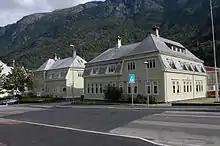
| Year | Pop. | ±% |
|---|---|---|
| 1951 | 8,807 | — |
| 1960 | 9,584 | +8.8% |
| 1970 | 10,051 | +4.9% |
| 1980 | 9,183 | −8.6% |
| 1990 | 8,289 | −9.7% |
| 2000 | 7,727 | −6.8% |
| 2010 | 7,047 | −8.8% |
| 2017 | 7,025 | −0.3% |
| Source: Statistics Norway. | ||
The Røldal Stave Church was built in the years 1200–1250 in the present-day village of Røldal. This is one of the oldest structures in the municipality.
During the 19th century, Odda became a significant tourist destination. Visits ranged from English pioneers around 1830 to the German Emperor Kaiser Wilhelm II, who visited Odda every year between 1891 and 1914. This led to the construction of several hotels in the municipality.
Odda Municipality was centred on a modern town which grew up around smelters built at the head of the Sørfjorden branch of the Hardangerfjord in the mid-twentieth century, drawing migrants from different parts of Norway.
The carbide production and the subsequent production of cyanamide was started in 1908 after the water power plant was operational and provided the necessary electricity for the arc furnaces. The plant was the largest in the world and remained operational till 2003 shortly after the plant was sold to Philipp Brothers Chemicals Inc. The Norwegian government tried to get the site recognized together with other industrial plants as a UNESCO World Heritage Site.[8][9][10] In 2010 an international report stated: What makes Odda smelteverk so important and central to the application of Norway’s hydro power sites and pioneer chemical industry as a World Heritage Site is the fact that here in an internationally unique way the physical remains of an early chemical production process are still present.[11]
Dialect
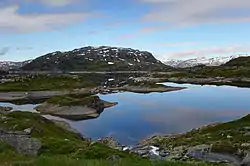
Odda grew up around this smelter in the early-twentieth century, drawing migrants from different parts of Norway. As a result, there developed a new dialect, a mixture of that spoken in the home regions of the migrants - a phenomenon termed by linguists "a Koiné language". The town of Odda and neighboring village of Tyssedal - which arose in the same time and socio-economic circumstances as those of Odda - provided valuable insights to linguists studying this phenomenon. The researcher Paul Kerswill conducted an intensive study of the Norwegian spoken in the two communities, relating them to very different geographical origins: The workers in Odda came predominantly (86%) from western Norway. In Tyssedal only about one third came from western Norway; one third came from eastern Norway; and the rest from other parts of the country. The dialects that evolved in these two communities were radically different from each other, though spoken at a short geographical distance from each other.
Government
All municipalities in Norway, including Odda, are responsible for primary education (through 10th grade), outpatient health services, senior citizen services, unemployment and other social services, zoning, economic development, and municipal roads. The municipality is governed by a municipal council of elected representatives, which in turn elect a mayor.[12] The municipality fell under the Hardanger District Court and the Gulating Court of Appeal.
Municipal council
The municipal council (Kommunestyre) of Odda is made up of 27 representatives that are elected to four year terms. The party breakdown of the final municipal council was as follows:
| Party Name (in Nynorsk) | Number of representatives | |
|---|---|---|
| Labour Party (Arbeidarpartiet) | 12 | |
| Conservative Party (Høgre) | 6 | |
| Christian Democratic Party (Kristeleg Folkeparti) | 1 | |
| Red Party (Raudt) | 2 | |
| Centre Party (Senterpartiet) | 2 | |
| Liberal Party (Venstre) | 3 | |
| The Moderates (Moderatene) | 1 | |
| Total number of members: | 27 | |
| Party Name (in Nynorsk) | Number of representatives | |
|---|---|---|
| Labour Party (Arbeidarpartiet) | 9 | |
| The Democrats (Demokratane) | 2 | |
| Conservative Party (Høgre) | 4 | |
| Red Party (Raudt) | 3 | |
| Centre Party (Senterpartiet) | 2 | |
| Liberal Party (Venstre) | 3 | |
| New Odda (Nye Odda) | 4 | |
| Total number of members: | 27 | |
| Party Name (in Nynorsk) | Number of representatives | |
|---|---|---|
| Labour Party (Arbeidarpartiet) | 10 | |
| Progress Party (Framstegspartiet) | 2 | |
| Conservative Party (Høgre) | 3 | |
| Red Party (Raudt) | 4 | |
| Centre Party (Senterpartiet) | 2 | |
| Liberal Party (Venstre) | 3 | |
| New Odda (Nye Odda) | 3 | |
| Total number of members: | 27 | |
| Party Name (in Nynorsk) | Number of representatives | |
|---|---|---|
| Labour Party (Arbeidarpartiet) | 9 | |
| The Democrats (Demokratane) | 1 | |
| Progress Party (Framstegspartiet) | 2 | |
| Conservative Party (Høgre) | 3 | |
| Red Electoral Alliance (Raud Valallianse) | 4 | |
| Centre Party (Senterpartiet) | 2 | |
| Socialist Left Party (Sosialistisk Venstreparti) | 3 | |
| Liberal Party (Venstre) | 3 | |
| Total number of members: | 27 | |
| Party Name (in Nynorsk) | Number of representatives | |
|---|---|---|
| Labour Party (Arbeidarpartiet) | 13 | |
| Progress Party (Framstegspartiet) | 2 | |
| Conservative Party (Høgre) | 6 | |
| Red Electoral Alliance (Raud Valallianse) | 3 | |
| Centre Party (Senterpartiet) | 2 | |
| Socialist Left Party (Sosialistisk Venstreparti) | 4 | |
| Liberal Party (Venstre) | 3 | |
| Total number of members: | 33 | |
| Party Name (in Nynorsk) | Number of representatives | |
|---|---|---|
| Labour Party (Arbeidarpartiet) | 17 | |
| Progress Party (Framstegspartiet) | 2 | |
| Conservative Party (Høgre) | 3 | |
| Red Electoral Alliance (Raud Valallianse) | 3 | |
| Centre Party (Senterpartiet) | 3 | |
| Socialist Left Party (Sosialistisk Venstreparti) | 3 | |
| Liberal Party (Venstre) | 2 | |
| Total number of members: | 33 | |
| Party Name (in Nynorsk) | Number of representatives | |
|---|---|---|
| Labour Party (Arbeidarpartiet) | 17 | |
| Progress Party (Framstegspartiet) | 2 | |
| Conservative Party (Høgre) | 5 | |
| Red Electoral Alliance (Raud Valallianse) | 3 | |
| Socialist Left Party (Sosialistisk Venstreparti) | 8 | |
| Liberal Party (Venstre) | 2 | |
| Joint list of the Centre Party (Senterpartiet) and the Christian Democratic Party (Kristeleg Folkeparti) | 4 | |
| Total number of members: | 41 | |
| Party Name (in Nynorsk) | Number of representatives | |
|---|---|---|
| Labour Party (Arbeidarpartiet) | 20 | |
| Progress Party (Framstegspartiet) | 2 | |
| Conservative Party (Høgre) | 7 | |
| Christian Democratic Party (Kristeleg Folkeparti) | 1 | |
| Red Electoral Alliance (Raud Valallianse) | 2 | |
| Centre Party (Senterpartiet) | 1 | |
| Socialist Left Party (Sosialistisk Venstreparti) | 5 | |
| Liberal Party (Venstre) | 3 | |
| Total number of members: | 41 | |
| Party Name (in Nynorsk) | Number of representatives | |
|---|---|---|
| Labour Party (Arbeidarpartiet) | 24 | |
| Progress Party (Framstegspartiet) | 1 | |
| Conservative Party (Høgre) | 6 | |
| Christian Democratic Party (Kristeleg Folkeparti) | 1 | |
| Red Electoral Alliance (Raud Valallianse) | 2 | |
| Centre Party (Senterpartiet) | 1 | |
| Socialist Left Party (Sosialistisk Venstreparti) | 4 | |
| Liberal Party (Venstre) | 2 | |
| Total number of members: | 41 | |
| Party Name (in Nynorsk) | Number of representatives | |
|---|---|---|
| Labour Party (Arbeidarpartiet) | 17 | |
| Conservative Party (Høgre) | 10 | |
| Communist Party (Kommunistiske Parti) | 1 | |
| Christian Democratic Party (Kristeleg Folkeparti) | 2 | |
| Liberal People's Party (Liberale Folkepartiet) | 1 | |
| Red Electoral Alliance (Raud Valallianse) | 3 | |
| Centre Party (Senterpartiet) | 1 | |
| Socialist Left Party (Sosialistisk Venstreparti) | 4 | |
| Liberal Party (Venstre) | 2 | |
| Total number of members: | 41 | |
| Party Name (in Nynorsk) | Number of representatives | |
|---|---|---|
| Labour Party (Arbeidarpartiet) | 19 | |
| Christian Democratic Party (Kristeleg Folkeparti) | 4 | |
| New People's Party (Nye Folkepartiet) | 2 | |
| Red Electoral Alliance (Raud Valallianse) | 1 | |
| Socialist Left Party (Sosialistisk Venstreparti) | 7 | |
| Liberal Party (Venstre) | 2 | |
| Joint list of the Conservative Party (Høgre) and the Centre Party (Senterpartiet) | 6 | |
| Total number of members: | 41 | |
| Party Name (in Nynorsk) | Number of representatives | |
|---|---|---|
| Labour Party (Arbeidarpartiet) | 18 | |
| Conservative Party (Høgre) | 2 | |
| Communist Party (Kommunistiske Parti) | 4 | |
| Centre Party (Senterpartiet) | 2 | |
| Socialist People's Party (Sosialistisk Folkeparti) | 3 | |
| Liberal Party (Venstre) | 7 | |
| Local List(s) (Lokale lister) | 5 | |
| Total number of members: | 41 | |
| Party Name (in Nynorsk) | Number of representatives | |
|---|---|---|
| Labour Party (Arbeidarpartiet) | 20 | |
| Conservative Party (Høgre) | 3 | |
| Communist Party (Kommunistiske Parti) | 4 | |
| Centre Party (Senterpartiet) | 1 | |
| Socialist People's Party (Sosialistisk Folkeparti) | 5 | |
| Liberal Party (Venstre) | 8 | |
| Total number of members: | 41 | |
| Party Name (in Nynorsk) | Number of representatives | |
|---|---|---|
| Labour Party (Arbeidarpartiet) | 22 | |
| Conservative Party (Høgre) | 3 | |
| Communist Party (Kommunistiske Parti) | 4 | |
| Centre Party (Senterpartiet) | 1 | |
| Socialist People's Party (Sosialistisk Folkeparti) | 3 | |
| Liberal Party (Venstre) | 8 | |
| Total number of members: | 41 | |
| Party Name (in Nynorsk) | Number of representatives | |
|---|---|---|
| Labour Party (Arbeidarpartiet) | 17 | |
| Conservative Party (Høgre) | 2 | |
| Communist Party (Kommunistiske Parti) | 7 | |
| Centre Party (Senterpartiet) | 1 | |
| Liberal Party (Venstre) | 6 | |
| Total number of members: | 33 | |
| Party Name (in Nynorsk) | Number of representatives | |
|---|---|---|
| Labour Party (Arbeidarpartiet) | 16 | |
| Conservative Party (Høgre) | 2 | |
| Communist Party (Kommunistiske Parti) | 8 | |
| Liberal Party (Venstre) | 7 | |
| Total number of members: | 33 | |
| Party Name (in Nynorsk) | Number of representatives | |
|---|---|---|
| Labour Party (Arbeidarpartiet) | 14 | |
| Conservative Party (Høgre) | 1 | |
| Communist Party (Kommunistiske Parti) | 11 | |
| Liberal Party (Venstre) | 5 | |
| Joint List(s) of Non-Socialist Parties (Borgarlege Felleslister) | 1 | |
| Total number of members: | 32 | |
| Party Name (in Nynorsk) | Number of representatives | |
|---|---|---|
| Labour Party (Arbeidarpartiet) | 11 | |
| Conservative Party (Høgre) | 1 | |
| Communist Party (Kommunistiske Parti) | 12 | |
| Liberal Party (Venstre) | 8 | |
| Total number of members: | 32 | |
| Party Name (in Nynorsk) | Number of representatives | |
|---|---|---|
| Labour Party (Arbeidarpartiet) | 10 | |
| Communist Party (Kommunistiske Parti) | 14 | |
| Joint List(s) of Non-Socialist Parties (Borgarlege Felleslister) | 8 | |
| Total number of members: | 32 | |
| Party Name (in Nynorsk) | Number of representatives | |
|---|---|---|
| Labour Party (Arbeidarpartiet) | 14 | |
| Communist Party (Kommunistiske Parti) | 7 | |
| Joint List(s) of Non-Socialist Parties (Borgarlege Felleslister) | 10 | |
| Local List(s) (Lokale lister) | 1 | |
| Total number of members: | 32 | |
Geography


Odda municipality was very mountainous and the settlements were all located in valleys. Because of the many mountains, there were many large waterfalls including Låtefossen, Espelandsfossen, and Tyssestrengene.[30] There are also many large lakes such as Sandvinvatnet, Votna, Valldalsvatnet, Røldalsvatnet, Ringedalsvatnet, Langavatnet, and parts of Ståvatn. On top of the high mountains in western Odda is the vast Folgefonna glacier, including the Buarbreen glacier near the town of Odda. Part of Folgefonna National Park is in Odda. The western part of the municipality sits on top of the southern part of the Hardangervidda plateau, which also includes part of the Hardangervidda National Park. The mountains Kistenuten and Sandfloegga are located on the plateau.
Transportation
The municipality sat at a crossroads of two major roads. The European route E134 highway runs east–west through Odda municipality, cutting through many mountains in the Røldal Tunnel, Horda Tunnel, Austmannali Tunnel, and Haukeli Tunnel. The other main road is the Norwegian National Road 13 which runs north–south through the municipality. The two roads run together from Seljestad to Håra. At Eitrheim, the Folgefonna Tunnel connects Odda to the neighboring area of Mauranger in Kvinnherad Municipality, cutting through the mountains under the Folgefonna glacier.
Health Care
Odda Hospital provides health services to the inhabitants of Hardanger. The ambulance station, Folgefonn DPS Odda and the municipal hospital are also located in the hospital area. The population can also receive health services at local health stations.
In popular culture
The town was used as the backdrop for the fictional town of Edda in the Netflix Norwegian-language drama series Ragnarok.
References
- "Navn på steder og personer: Innbyggjarnamn" (in Norwegian). Språkrådet.
- "Forskrift om målvedtak i kommunar og fylkeskommunar" (in Norwegian). Lovdata.no.
- Statistisk sentralbyrå (2017). "Table: 06913: Population 1 January and population changes during the calendar year (M)" (in Norwegian). Retrieved 2017-10-24.
- Jukvam, Dag (1999). "Historisk oversikt over endringer i kommune- og fylkesinndelingen" (PDF) (in Norwegian). Statistisk sentralbyrå.
- "Ullensvang kommune - den nye kommune i Hardanger" (in Norwegian). Retrieved 2017-10-24.
- Rygh, Oluf (1919). Norske gaardnavne: Nordre Bergenhus amt (in Norwegian) (12 ed.). Kristiania, Norge: W. C. Fabritius & sønners bogtrikkeri. p. 443.
- "Civic heraldry of Norway - Norske Kommunevåpen". Heraldry of the World. Retrieved 2020-02-08.
- Heiden, Noland R (1952). "Odda and Rjukan: Two Industrialized Areas of Norway". Annals of the Association of American Geographers. 42 (2): 109–128. doi:10.1080/00045605209352058. JSTOR 2560975.
- "Rjukan/Notodden and Odda/Tyssedal Industrial Heritage Sites, Hydro Electrical Powered Heavy Industries with associated Urban Settlements (Company Towns) and Transportation System". UNESCO. Retrieved 2010-06-29.
- Torpey, Paul (3 October 2007). "Industrial revolution". The Guardian. London. Retrieved 2012-11-19.
- Riksantikvaren, Taming the Waterfalls Archived 2014-02-22 at the Wayback Machine, Retrieved 2014-02-05.
- Hansen, Tore, ed. (2016-05-12). "kommunestyre". Store norske leksikon (in Norwegian). Kunnskapsforlaget. Retrieved 2019-04-06.
- "Table: 04813: Members of the local councils, by party/electoral list at the Municipal Council election (M)" (in Norwegian). Statistics Norway.
- "Tall for Norge: Kommunestyrevalg 2011 - Hordaland". Valg Direktoratet. Retrieved 2020-02-02.
- "Kommunestyrevalget 1995" (PDF) (in Norwegian). Oslo-Kongsvinger: Statistisk sentralbyrå. 1996. Retrieved 2020-05-14.
- "Kommunestyrevalget 1991" (PDF) (in Norwegian). Oslo-Kongsvinger: Statistisk sentralbyrå. 1993. Retrieved 2020-05-14.
- "Kommunestyrevalget 1987" (PDF) (in Norwegian). Oslo-Kongsvinger: Statistisk sentralbyrå. 1988. Retrieved 2020-05-14.
- "Kommunestyrevalget 1983" (PDF) (in Norwegian). Oslo-Kongsvinger: Statistisk sentralbyrå. 1984. Retrieved 2020-05-14.
- "Kommunestyrevalget 1979" (PDF) (in Norwegian). Oslo: Statistisk sentralbyrå. 1979. Retrieved 2020-05-14.
- "Kommunevalgene 1975" (PDF) (in Norwegian). Oslo: Statistisk sentralbyrå. 1977. Retrieved 2020-05-14.
- "Kommunevalgene 1972" (PDF) (in Norwegian). Oslo: Statistisk sentralbyrå. 1973. Retrieved 2020-05-14.
- "Kommunevalgene 1967" (PDF) (in Norwegian). Oslo: Statistisk sentralbyrå. 1967. Retrieved 2020-05-14.
- "Kommunevalgene 1963" (PDF) (in Norwegian). Oslo: Statistisk sentralbyrå. 1964. Retrieved 2020-05-14.
- "Kommunevalgene og Ordførervalgene 1959" (PDF) (in Norwegian). Oslo: Statistisk sentralbyrå. 1960. Retrieved 2020-05-14.
- "Kommunevalgene og Ordførervalgene 1955" (PDF) (in Norwegian). Oslo: Statistisk sentralbyrå. 1957. Retrieved 2020-05-14.
- "Kommunevalgene og Ordførervalgene 1951" (PDF) (in Norwegian). Oslo: Statistisk sentralbyrå. 1952. Retrieved 2020-05-14.
- "Kommunevalgene og Ordførervalgene 1947" (PDF) (in Norwegian). Oslo: Statistisk sentralbyrå. 1948. Retrieved 2020-05-14.
- "Kommunevalgene og Ordførervalgene 1945" (PDF) (in Norwegian). Oslo: Statistisk sentralbyrå. 1947. Retrieved 2020-05-14.
- "Kommunevalgene og Ordførervalgene 1937" (PDF) (in Norwegian). Oslo: Statistisk sentralbyrå. 1938. Retrieved 2020-05-14.
- https://www.aftenposten.no/reise/i/EppvrP/paa-tur-til-stedet-der-ingen-orket-aa-stoppe
External links
 Media related to Odda Municipality at Wikimedia Commons
Media related to Odda Municipality at Wikimedia Commons- . Encyclopædia Britannica (11th ed.). 1911.
- Municipal fact sheet from Statistics Norway (in Norwegian)
